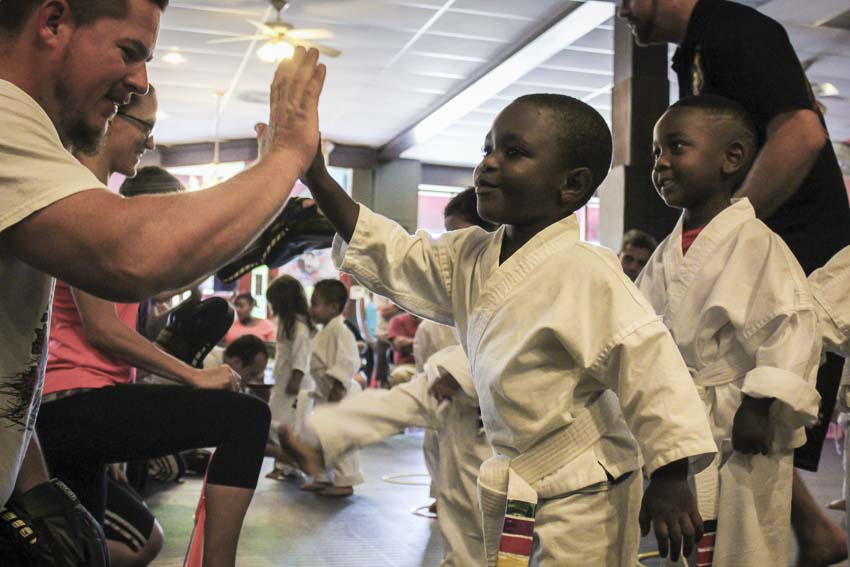There are many steps to Building a Fun Kung Fu Kids Class. You can vary teaching styles based on age, style of martial art, and size of the class. Regardless of these factors there are a few things you can do to make sure that you are running and fun and engaging kids program. These are some of the things we do at the Sifu Och Wing Chun and Just Dance Afterschool and Martial arts Programs.

Building a Fun Kung Fu Kids Class: Part 1 Discipline
The very first thing that you must have when running any kids program is a focus on discipline. When the class is smaller, under 15-20 students, it can be easy to slack off give them more leeway. However, if good discipline is not integrated early in the program it will be difficult to maintain that when the class gets closer to 25+. What you must feel is the class energy. If the kids are engaged, following instructions, working hard, there will obviously be a very good energy in the class.

On the other hand, if there are children that are whispering to each other, spending too much time fixing a shoe or belt, etc. there will be a hiccups in flow of class. When you feel the flow of energy weakening you must change the class dynamic. But more on that later.

One of the first tricks we to maintain class discipline and structure is using the word discipline itself. When one of our instructors calls “discipline” the entire class responds with “yes sir” and stands at perfect attention. To compliment that you must enforce this and any other rules without hesitation or exception.
When we call discipline if any child speaks, doesn’t stand up, or is distracting another student we address it immediately. We enforce this with burpees. To keep the group together we will tell the students to start the burpee by saying “down”. When we say “up” we have them stand back up in discipline and say “yes sir”. This is repeated as many times as necessary until the group is performing this quickly as a unit.
Building a Powerful Kung Fu Kids Class Part 2: Class Dynamic
The next aspect we will discuss is the class dynamic. As mentioned earlier you need to feel the energy in class. If you have classes that include children as young as 5 years old you will find that they my struggle more so with paying attention. If you also have a larger class this problem is compounded. To help maintain a fun but focused atmosphere you have to be able to make adjustment quickly. By interchanging combos with a mini work out you can quickly re-engage those who may be distracted.
The next aspect we will discuss is the class dynamic. As mentioned earlier you need to feel the energy in class. If you have classes that include children as young as 5 years old you will find that they my struggle more so with paying attention. If you also have a larger class this problem is compounded. To help maintain a fun but focused atmosphere you have to be able to make adjustment quickly. By interchanging combos with a mini work out you can quickly re-engage those who may be distracted.

Teaching a basic combo like Jab, uppercut, round house, can be either very fun, or very boring. If you mix it into a fun work out to get the student’s moving you lift the overall energy. For example: if we have the students run in place, switch to high knees, then immediately take a fighting stance. Quickly follow up with the combo two or three times. Then we have them isolate one or two of those techniques and repeat them. The go back to the high knees, or jumping jacks etc. By cycling through different mini workouts, techniques, and other options you can keep the class very exciting.
Building a Powerful Kung Fu Kids Class Part 2: Fun!
The last thing is of course have fun with them. If you as the instructor have an upbeat excited attitude then the students will more than likely emulate that. By embracing your inner child you can usually find new and engaging ways to energize the class. Have fun, maintain discipline, and you will have quite a enjoyable kids class.

Why Choose Sifu Och Wing Chun
Practicing provides numerous benefits, including:
- Physical Fitness: Enhance strength, flexibility, and endurance.
- Mental Clarity: Develop focus and discipline through structured training.
- Self-Defense Skills: Learn effective techniques for personal safety.
- Cultural Enrichment: Gain insight into a centuries-old tradition.

Want to Get Started?
Join Sifu Och Wing Chun today and embark on your journey through the world. Fill out our contact form to discover why we are your best choice for Wing Chun Kung Fu and martial arts training in Lakeland, Florida!
Related articles on the Sifu Och Wing Chun website:
Cuts, Collisions, & Crying: Tips for Your Kids Program
https://sifuochwingchun.com/cuts-collisions-crying-tips-for-your-kids-program/
Exercising Kids and Training Kids Goes Hand in Hand
https://sifuochwingchun.com/exercising-kids-training/




